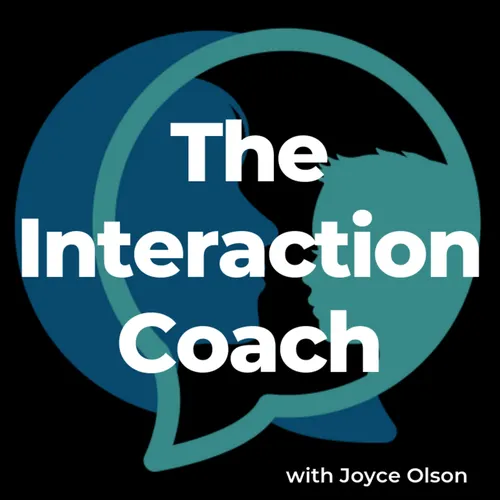
The Interaction Coach
You can help your child learn to talk with speech-language pathologist Joyce Olson of The Interaction Coach. Listen to daily tips that make every interaction a learning opportunity for speech and language development. Whether your child needs to start using words, make longer sentences, or improve social communication, this podcast is for you.
- Update frequency
- every day
- Average duration
- 6 minutes
- Episodes
- 234
- Years Active
- 2019 - 2020

2.054 PLAY: Object Use: Reach with one arm for object
Joyce talks about a course for parents who want resources, coaching or therapy services that directly address their child’s communication needs. Find out more here.
Today’s activity: Hold one object…

2.053 PLAY: Attention to objects: Alternate attention between two objects
Alternating attention between two objects helps your child learn to scan their vision between two objects, which will help them when they want to make choices between objects.
The activity helps your…

2.052 PLAY: Attention to objects: Use a variety of sounds
Attention to objects helps your child learn about their world. They can pay attention with their vision or hearing.
Today’s activity: Use a variety of child-safe objects that make sounds to attract y…

2.051 PLAY: Attention to objects: Use a noisy toy
Attention to objects lays the foundation for learning concepts. As they explore their world, they learn about the characteristics of objects.
Your child’s attention becomes more focused during this l…

2.050 SOCIAL INTERACTION: Affect and Engagement: Respond to child’s cues
Your child is refining and expanding the ways they can respond to you. At the same time, you are becoming more aware of the body signals they are sending that let you know their interests and prefere…

2.049 SOCIAL INTERACTION: Affect and Engagement: Enjoy music together
Music is another way for your child to learn about sounds and voices.
Today’s activity: Move in time to music to help your child feel the rhythm. Sing to associate your voice and intonation with the …

2.048 SOCIAL INTERACTION: Affect and Engagement: Use vocal inflections
Vocal inflections are the expressiveness you put into your voice—such as surprise, excitement, scolding, soothing.
Using exaggerated vocal inflections helps your child notice the importance of these …

2.047 SOCIAL INTERACTION: Affect and Engagement:: Use play routines
Joyce confesses to a mistake she made when shaping her grandson’s responses during a play routine in Level Two.
Extinction is when a behavior disappears from use because it is not being reinforced.
E…

2.046 SOCIAL INTERACTION: Affect and Engagement: Social game “so big”
A social game is a shared activity where you enjoy spending time together by engaging in a familiar back-and-forth routine. Notice that this skill emerges as children are just learning to get another…

2.045 SOCIAL INTERACTION: Turn Taking: Making sounds
Turn taking with sounds develops after your child has been doing some turn taking with movements.
Imitating sounds doesn’t just happen as soon as you start modeling sounds. We “shape” that response b…

2.044 SOCIAL INTERACTION: Turn Taking: Get the wiggles out
Turn taking is an important conversation skill that started at Level 1. Now your child is showing more ways they can respond to you when they take a turn in your back-and-forth social exchanges.
Rein…

2.043 JOINT ATTENTION: Observe how your child shows interest, disinterest or discomfort
We build joint attention by using objects the child finds interesting. You need to know how your child shows this interest.
Start building joint attention by engaging with objects your child finds in…

2.042 JOINT ATTENTION: Watch an object as it moves away
Joint attention is when you both are paying attention to the same object or activity.
At Level Two, your child is building skills that are needed for joint attention such as recognizing things at a d…

2.041 MUTUAL ATTENTION: Pull child on blanket toward you
This activity allows tummy time and encourages your child to want to move toward you.
Today’s activity: Put your child on tummy on a blanket on the floor or a bed. Be face-to-face at your child’s eye…

2.040 MUTUAL ATTENTION: Mirror play
We all enjoy looking at ourselves in the mirror. Your child will enjoy watching and peeking in the mirror.
Today’s activity: Use a child-safe mirror. You can move the mirror up and down to play peek-…

2.039 MUTUAL ATTENTION: Let child explore your face
Your child will learn to recognize your face from a distance.
Children learn through action and touch. When you let your child explore your face, it becomes even more familiar.
Today’s activity: Allo…

2.038 MUTUAL ATTENTION: Practice serve-and-return
Mutual attention is paying attention to each other, noticing what the other person is doing and responding to the other person.
Harvard’s Center on the Developing Child has researched the early Serve…

1.037 LITERACY: Writing: Grasp index finger
Read blog post summarizing Level One.
Download the list of Level One Targets and Activities.
Writing requires using fine motor skills (small movements of fingers). Your child starts to develop thes…

1.036 LITERACY: Reading: Bat at objects
Children need coordinated eye movements for reading. This starts to develop at Level One, when your child starts to wave toward objects they see.
With practice, your child’s arm movements will be dir…

1.035 LANGUAGE: Use Speech: Consult a specialist for feeding problems
Speech is a complex task that requires coordinated muscle movements of your lips, tongue, throat, breathing and more. Difficulty with feeding can be an early indicator of later problems with forming …